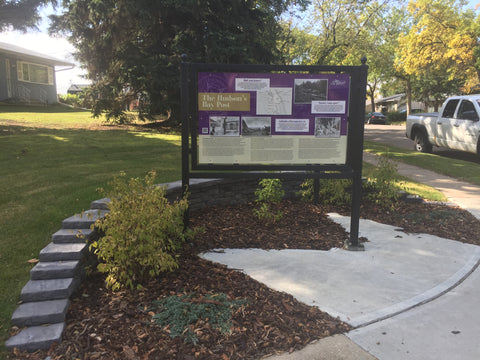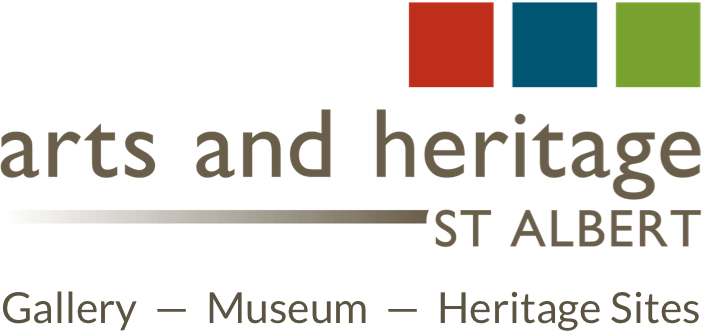
ONLINE EXHIBITION
15A. The Hudson's Bay Post
The Hudson's Bay Post
Anthony Henday led the first expedition of the Hudson’s Bay Company (HBC) to this area in 1755, camping at the mouth of the Sturgeon River. In 1795, the company built the first Edmonton House (Fort Edmonton) one mile upstream, near the location of the future North-West Mounted Police Fort Saskatchewan. The HBC and its competitors, the North West Company, began trading with the many First Nations people in the region. Edmonton House journals list over a dozen different communities that came to trade at the fort. As the HBC expanded, more posts were added to improve trade and transport. In 1866 a small trading post was opened in St. Albert, not far from this spot, near St. Vital Avenue.
The St. Albert post was closer for traders from points north to bring their furs and other goods. It was also a link in the chain of supplies needed to support Fort Edmonton. Much of their winter food supply relied on dried fish from Lac Ste. Anne. During the winter, goods were hauled using dog sleds and larger horse sleds. The first “Clerk in Charge” was John Cunningham, a Métis man who had worked at Lac St. Anne and Fort Edmonton. In 1868, when Cunningham was killed on a buffalo hunt, freighter and trader Louis Chastellain took over the post. Chastellain retired from the HBC in 1878, after 45 years of service. He bought the old post land and opened his own store: one of St. Albert’s first private businesses.
En 1755, l’explorateur Anthony Henday a guidé la première expedition de la Compagnie de la Baie d’Hudson (HBC) jusqu’ici. Ils se sont installés au bout de la rivière Esturgeon. La première Edmonton House (Fort Edmonton) a été construite en 1795 à un mile du bout de la rivière Esturgeon, près du lieu où la Police Montée du Nord-Ouest a construit le Fort Saskatchewan en 1875. La HBC avec leurs compétiteurs la Compagnie du Nord Ouest, a commencé le commerce avec les communautés des Premières Nations de la région. Les journaux d’Edmonton House ont une liste d’une douzaine de groupes différents qui seraient venus faire des échanges au fort. À mesure que la HCB prenait de l’expansion, plus de postes ont été ajoutés pour améliorer le commerce et le transport. En 1866, un petit poste de commerce a été érigé à St-Albert, près de l’avenue St-Vital.
Les marchands venaient au poste de commerce à St-Albert pour échanger leurs fourrures et d’autres biens à cause de sa proximité du nord. Le poste était aussi un lien essentiel à la chaine de matériaux en direction du Fort Edmonton. Ils comptaient sur les poissons séchés du Lac St-Anne pour la majorité de leurs réserves de nourriture pour l’hiver. L’hiver, les marchandises étaient transportées par des traineaux à chiens et de grands traineaux à cheval. Le métis, John Cunningham, qui avait travaillé au Lac Ste-Anne et au Fort Edmonton, a été le premier commis du poste à St-Albert. Après sa mort lors d’une chasse au bison en 1868, le poste de commis a été pourvu par Louis Chastellain, un expéditeur et un commerçant, jusqu’en 1878 lorsqu’il a pris sa retraite de la HBC après 45 ans de service. Il a acheté l’ancien terrain du poste de commerce et a ouvert son proper magasin, une des premières entreprises privées à St-Albert.
Anthony Henday kînîkânîstam nistam itohtêwin anita ohci Hudson’s Bay Company (HBC) otê isîh êkospî 1755, kîmânokêwâk sâkitawâhk namêw sîpîhk. ispî 1795, wâskahikanihkâtamwak amiskwaciy wâskahikan (pêhonân tasih amiskwaciy wâskahikan) pêyak mistik natimihk sîpîhk, cîki nîkânihk ôma Fort Saskatchewan. HBC êkwa mawinêhowêwak, North West Company, mâcihatâmêwak iyiniwak ôta ohci. amiskwaciy wâskahikan masinahikatêyiwa ayiwâk nîsosâp pîtos
mâmawinitowak êpê mêskotônikêcik ôta atâwêwikamikohk. ayiwâk HBC kâ-ati-pihcâhk, ayiwâk atâwêwikamikwa tahkwastâwâk ayiwâk kwêyask kamêskotônikêcik êkwa kapimohtacikêcik. ispî 1866, êhapisâsik pêhonânikamik yotênamwak anita St. Albert, namôya wâhyaw ôta, cîki St. Vital Avenue.
St. Albert atâwêwikamik nawâc cîki ohci otatâwêwak kîwêtinôhk ohci kapêtâcik wayâna êkwa kotak âpacîcikana. êkwa mîna kimiyohapacîhtâwak kawîcihâcik Fort Edmonton. mistahi opiponimîciwin kîpakosêyimowak namêstêk ohci Lac Ste. Anne. kâmêkwâpipohk, atimotâpânâsk êkwa mistatim ocâpânaskos âpacihtâwak kahâwahtâhcik âpacihtâwina. nistam “ocacawês” êsa John Cunningham, otipêyimisow nâpêw kîhatoskêw Lac St. Anne êkwa Fort Edmonton. ispî 1868, Cunningham kînipahâw anita paskwâwimostos nôcihcikêwin, otatâwêw Louis Chastellain kîmâcatoskêw êkota. Chastellain kîpônatoskêw ohci HBC ispî 1878, êwako anima nêmitanaw niyânan askiy kâkîpêhatoskêt. kîhâtawêw kayâs atâwêwikamik askiy êkwa yôtenam wiya ka tipêyawêhohk atâwêwikamik: pêyak ôma St. Albert nîkân atâwêwikamikwa.
“mistatim kanawastimwêwak” anita Big Lake. ohpimê kîkanawêyimêwak mistatimwa kanâkatêyimâcik ohci iyiniwak nitopayowina. âtiht HBC napêwak kanâkatêyimâcik mistamwak, kîkisâtamwak cîki sâkahikanihk.




